When cooking at lower temperatures, you'll need to adjust your spicing strategy for ideal flavor. Add robust whole spices like cinnamon and cardamom early in the cooking process to allow proper infusion, while using fewer ground spices overall since less evaporation occurs. Layer your seasonings strategically: start with whole spices in oil, add medium-strength spices halfway through, and save delicate herbs for the final stages. You'll want to taste frequently and adjust gradually, as lower temps actually intensify certain flavors. Understanding these temperature-based spicing principles will transform your slow-cooked dishes from good to exceptional.
Understanding Solar Cooking Heat Levels
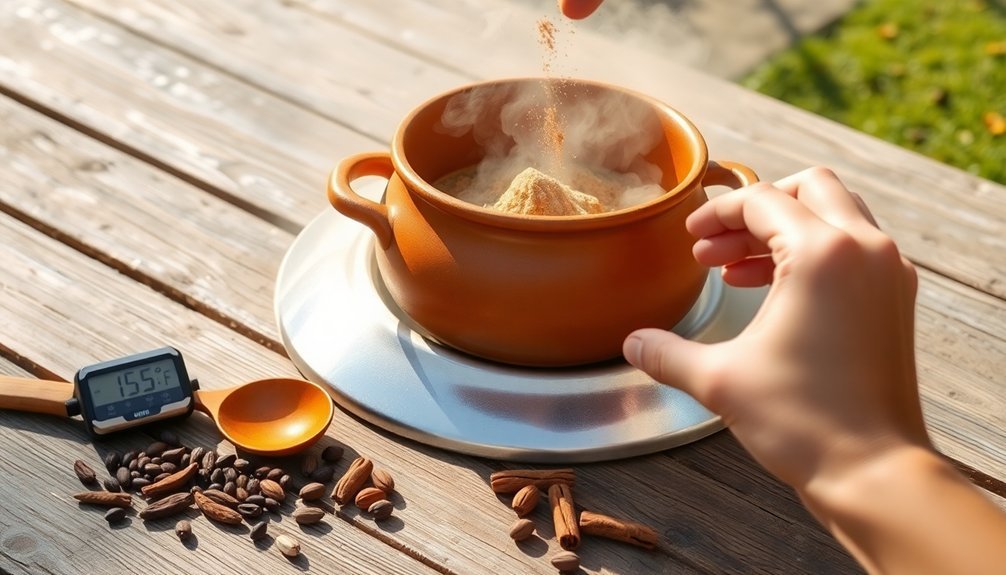
When cooking with solar power, understanding the distinct heat levels across different cooker types is essential for successful meal preparation.
Box cookers operate at moderate temperatures up to 165°C, making them ideal for slow cooking and water sterilization. Panel cookers reach around 121°C, suitable for basic heating tasks, while parabolic cookers can hit impressive temperatures above 290°C, allowing you to grill and stir-fry quickly.
You'll find that vacuum tube cookers perform well even in challenging weather conditions, matching parabolic cookers' high temperatures. In optimal conditions, a well-constructed solar cooker can achieve temperatures over 400°F while still being energy efficient.
To maintain ideal heat levels, you'll need to take into account factors like insulation, wind protection, and proper positioning toward the sun. Regular adjustments throughout the day and using appropriate accessories, such as reflectors or thermal storage materials, will help you achieve and maintain your desired cooking temperature.
Spice Timing for Solar Dishes
Timing your spice additions strategically can make or break a solar-cooked dish. When using your solar cooker, you'll want to add robust spices at the beginning to create a flavorful oil base, but be careful not to burn them. This works especially well for slow-cooked stews and curries.
For soups and longer-cooking dishes, add your spices midway through the cooking process. The Global Sun Oven method typically requires 3-4 hours of cooking time, giving spices plenty of time to develop. You'll get deeper flavors this way, as the spices won't cook off too quickly. Remember to adjust quantities based on your cooking time – solar cooking's slower nature means you might need less than traditional recipes call for.
Don't forget about final touches. You can add delicate spices or garnishes just before serving to create fresh flavor bursts and visual appeal. Always taste and adjust seasonings before serving.
Whole Versus Ground Spices
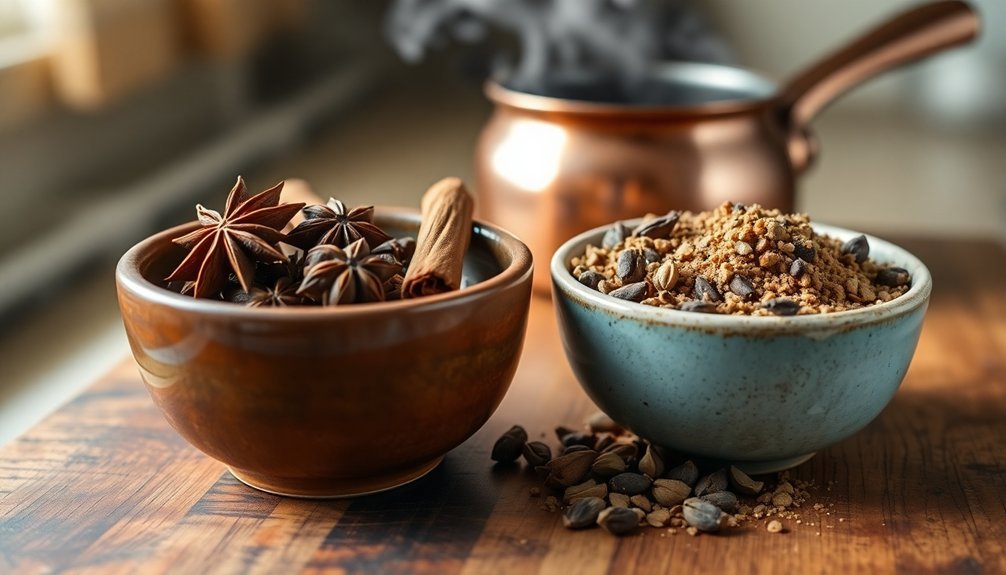
When you're cooking, you'll find that whole spices maintain their freshness longer and release their flavors gradually, while ground spices offer immediate, intense flavor bursts.
If you're working with whole spices, add them early in your cooking process to allow their oils to infuse thoroughly. Most ethnic cuisines rely on whole spices to achieve their authentic flavors.
You can toast them first to enhance their aroma, then remove them before serving or contain them in a muslin bag.
For ground spices, you've got more flexibility – add them at any point, even near the end of cooking.
Essential Temperature Monitoring Tools
You'll need reliable digital probes and thermometers to guarantee your spices are added at the right cooking temperatures. Tools like the Thermapen Classic offer quick 1-second readings, while the Combustion Inc Predictive Thermometer provides precise surface-to-center measurements.
Temperature control fan systems, such as the InkBird ITC-308, can help maintain consistent heat levels when working with temperature-sensitive spices in proofing chambers or controlled environments. Having temperature data loggers in multiple locations provides comprehensive monitoring of your cooking environment.
These monitoring tools let you track both ambient and internal temperatures accurately, which is essential since spices can lose their potency or become bitter when exposed to excessive heat.
Digital Probes and Thermometers
Modern digital probes and thermometers have revolutionized temperature monitoring in the kitchen, making it easier than ever to achieve perfectly cooked dishes.
You'll find several types to suit your cooking needs: digital probes that stay in the meat while cooking, instant-read thermometers for quick checks, and thermometer-fork combinations ideal for grilling.
For the most precise results, insert the probe 2 to 2½ inches into the thickest part of your food, avoiding bones and fat.
Many digital thermometers offer helpful features like temperature alerts, wireless monitoring up to 165 feet, and multiple probes for tracking different dishes simultaneously.
You can trust their accuracy within a range of 32 to 392 degrees F, and some models even allow calibration for fine-tuning.
Remember to test your thermometer's accuracy using ice or boiling water.
Temperature Control Fan Systems
Beyond digital probes and thermometers, temperature control fan systems represent a remarkable advancement in cooking precision.
You'll find these systems automatically adjust airflow based on your cooker's size and type, preventing flare-ups while maintaining ideal temperatures throughout your cooking session.
The systems feature SMART COOK settings with pre-programmed modes that you can select with a single button press.
You'll appreciate the RAMP MODE, which detects when your food approaches its target temperature and automatically shuts off the fan.
These systems also include open lid detection to minimize temperature disruption.
You can install these fans on most smokers and grills, including Kamado and Weber models.
They're compatible with specific controllers like ProTemp S1 and ProTemp 2 Plus, and you can control them remotely through an app.
Balancing Heat and Flavor
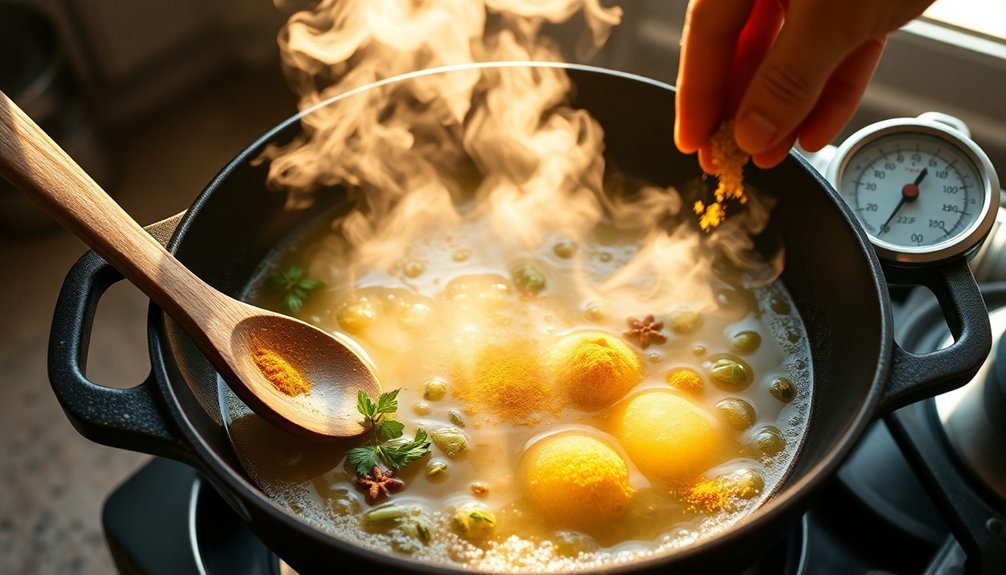
When mastering the art of seasoning, understanding the delicate interplay between heat and flavor becomes essential for creating well-balanced dishes. You'll notice that lower temperatures allow ingredients to release their flavors gradually, resulting in more intense umami notes. When working with spicy ingredients, you can achieve harmony by carefully balancing heat levels with complementary flavors.
| Heat Level | Characteristics | Best Uses | Key Ingredients | Balancing Elements |
|---|---|---|---|---|
| Mild | Subtle warmth | Background heat | Black pepper | Sweet notes |
| Moderate | Noticeable kick | Everyday dishes | Jalapeños | Dairy products |
| Medium | Pleasant heat | Main dishes | Chili powder | Acidic elements |
| Hot | Intense spice | Bold flavors | Habaneros | Cooling herbs |
| Extreme | Powerful heat | Special dishes | Ghost peppers | Sweet/creamy bases |
Remember to test your seasoning at slightly cooler temperatures for more accurate flavor assessment.
Solar Cooking Equipment Selection
Four distinct types of solar cookers offer unique advantages for eco-friendly outdoor cooking.
Panel cookers work best for dishes that don't need frequent stirring, using high-temperature bags and lids to lock in heat and flavor.
Box cookers feature insulated walls and a glass top, creating a reliable heat trap that's perfect for slow-cooking meals and sterilizing water.
If you're looking to achieve high temperatures, parabolic cookers concentrate sunlight to reach up to 700°F, letting you fry and grill, but they'll need constant adjustment.
For versatile cooking in various weather conditions, consider tube cookers—they use vacuum technology to trap heat effectively, even in low light, and can maintain temperatures up to 550°F.
Just handle them carefully to prevent damage.
Herb and Oil Combinations
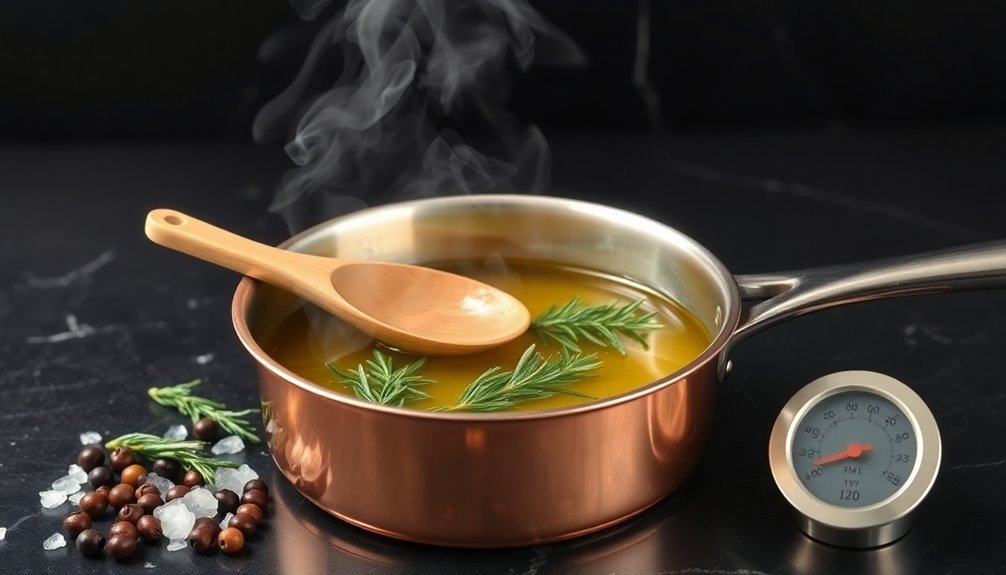
When infusing herbs into oils, you'll want to choose fresh herbs like basil, parsley, or mint and blend them with high-quality olive oil or another preferred oil base.
You can control the intensity of flavor by adjusting the herb-to-oil ratio and monitoring the blending time, typically around 30 seconds to avoid overheating.
The temperature should remain cool during preparation, and you'll need to strain the mixture through a fine cheesecloth or coffee filter before storing it in a dark, cool place to preserve its flavors.
Infusing Herbs Into Oils
Creating delicious herb-infused oils starts with selecting the right combination of herbs and carrier oils. You'll need to choose from options like rosemary, lavender, or calendula, paired with carriers such as sweet almond, coconut, or olive oil. For ideal results, use a clean glass jar and follow a ratio of 1:5 for dried herbs or 1:3 for fresh herbs to oil.
- Sterilize all equipment to prevent contamination
- Cover herbs completely with oil and remove air bubbles
- Store in a warm, dark place for 4-6 weeks
- Strain through cheesecloth or muslin cloth
When using fresh herbs, remember to acidify them with citric acid or vinegar to prevent botulism.
The process requires patience, but you'll be rewarded with flavorful, aromatic oils perfect for cooking or natural remedies.
Time and Temperature Control
Understanding time and temperature control for herb and oil combinations can transform your cooking results from mediocre to exceptional.
You'll want to add whole spices to hot oil first, as this helps integrate flavors throughout your dish. Keep temperatures below 365°F (185°C) to maintain antioxidant properties, especially when working with cloves and cinnamon.
When you're working with turmeric, add it early in the cooking process with fat to increase its bioavailability.
Add aromatic spices like garlic and ginger after your whole spices, and save powdered spices for later in the cooking process. If you're making soups or stews, introduce spices midway through cooking for ideal flavor development.
Remember to toast your spices beforehand to release their essential oils, but watch carefully to prevent burning, which can create bitter flavors.
Traditional Versus Solar Spicing
Traditional and solar cooking methods require distinctly different approaches to spicing due to their contrasting temperature ranges and cooking environments.
When you're cooking traditionally at high temperatures (above 260°C), spices release their flavors quickly and can burn or lose potency. You'll need to adjust quantities and timing carefully to prevent flavor loss.
In contrast, solar cooking's lower temperatures (82-121°C) preserve spice flavors and allow for gradual, even release throughout the cooking process.
- Traditional cooking needs more immediate spice addition due to shorter cooking times
- Solar cooking enables layered spicing at different stages for complex flavors
- High-heat methods require more spices to compensate for evaporation and heat loss
- Lower temperatures maintain spice potency, often requiring smaller quantities
Spice Distribution Methods
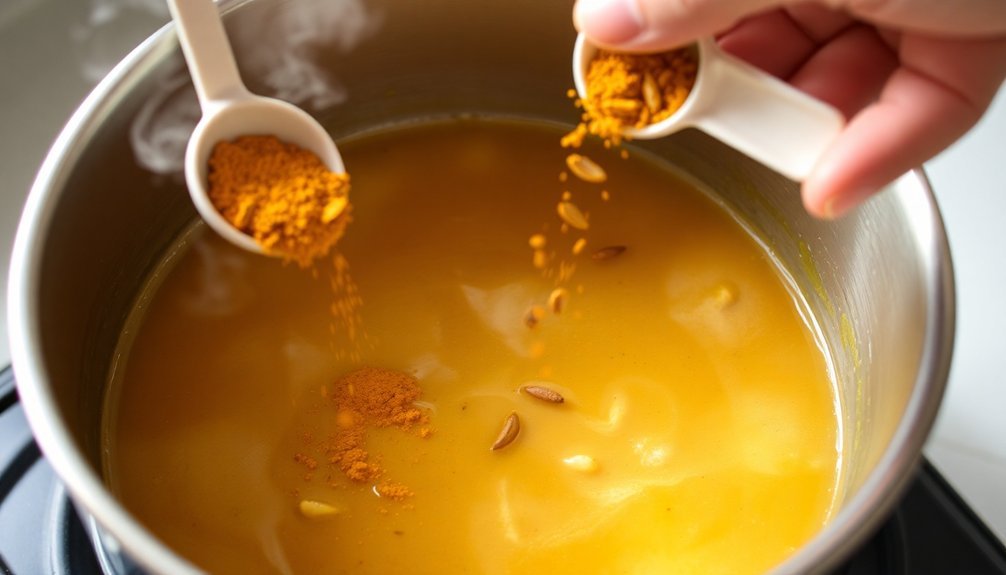
The art of distributing spices throughout your dishes can transform good cooking into exceptional cooking.
You'll want to layer your spices strategically, starting with whole spices in hot oil to create an aromatic base. Add ground spices later to guarantee they're evenly distributed without burning.
For maximum impact, try blooming your spices in oil or ghee to release their essential oils. When you're working with dry spices, toast them in a pan over low heat until they become fragrant.
You can also infuse oils and marinades with spices to create deeper flavor profiles. Remember to select a dominant base spice, then build complementary flavors around it.
For cold dishes, you'll need to add spices well in advance to allow the flavors to properly develop and meld together.
Managing Extended Cooking Times
When cooking dishes over extended periods, you'll need to check temperature points regularly to prevent spices from burning or losing their potency.
You'll notice how certain spices develop deeper flavors during long cooking processes, particularly in stews and braises where the heat slowly extracts and melds the spice compounds.
It's essential to add your spices at strategic times – some at the beginning for deep flavor development, others near the end to maintain their bright notes.
Temperature Control Check Points
Successfully managing extended cooking times requires careful planning and strategic temperature control checkpoints throughout your recipe.
You'll need to carefully monitor heat levels, adjusting from high to low depending on your cooking technique. For delicate dishes like beans or chicken stock, start at 5-7 to reach temperature, then reduce to a gentle 1-3 simmer for the duration.
- Never use the highest heat setting unless you're boiling water
- Set stir-fry pans to 8-9 after a 2-3 minute preheat
- Keep sautéing temperatures around 5, reducing to 4 if needed
- Maintain low heat (1-3) for long-cooking stews and braises
Remember to work backwards from your serving time, allowing buffer periods for temperature adjustments and unexpected delays.
Using mise en place helps you stay organized while managing these critical temperature checkpoints.
Flavor Development Over Time
Building on proper temperature control, mastering flavor development during extended cooking times takes your dishes to new heights.
You'll notice how spices gradually release their complex flavors, especially when you add them at different stages of cooking. Don't rush this process – patience allows the ingredients to meld perfectly.
For best results, dry roast your whole spices before cooking and add them midway through the process to prevent burning.
During long simmering periods, you'll want to wait until the last 45 minutes to add herbs. Remember that dried herbs pack more punch than fresh ones.
As you extend cooking time, you'll see how liquids reduce and flavors concentrate naturally. This slower approach helps break down tough meat cuts while ensuring spices fully integrate into your dish.
Timing Spice Additions Strategically
The strategic timing of spice additions can transform your dish from good to exceptional.
You'll want to add whole spices like cinnamon, cardamom, and cumin early in the cooking process to release their essential oils and develop deep flavors. For spices that can become overpowering, like paprika or chili powder, add them midway through cooking to achieve the perfect balance.
- Add robust whole spices at the start for maximum flavor infusion
- Introduce medium-strength spices halfway through cooking
- Save delicate herbs and ground spices for the final minutes
- Layer spices in slow-cooked dishes for depth and complexity
For slow-cooking methods, you'll benefit from a dual approach: start with hearty spices early on, then finish with fresh herbs and ground spices to maintain vibrancy and complexity in your final dish.
Seasonal Spice Adjustments
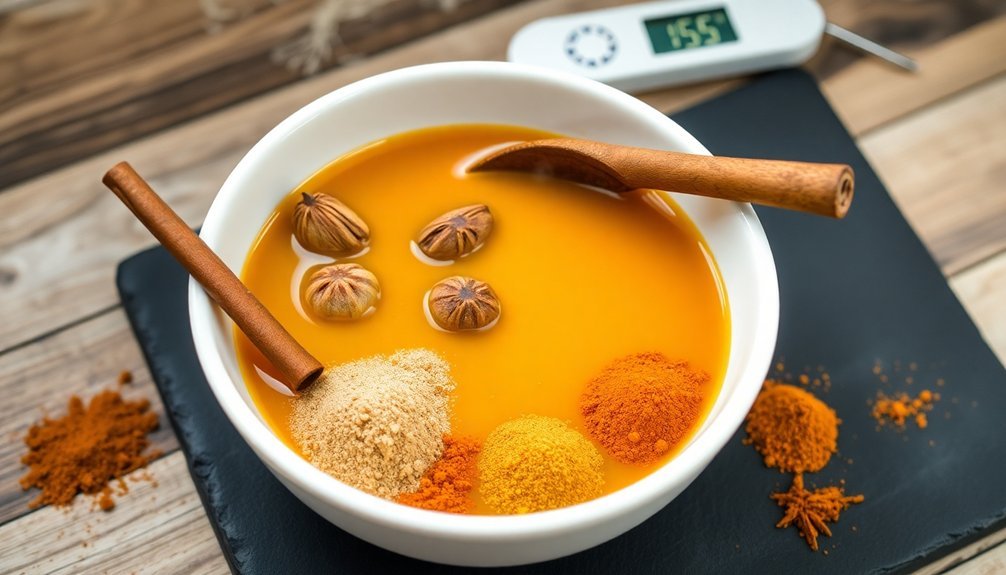
Making smart seasonal adjustments to your spice selections can dramatically enhance the flavors of your dishes throughout the year.
In spring, you'll want to embrace the mild, briny notes of fermented green peppercorns in your sauces and marinades, perfectly complementing fresh asparagus and spring vegetables.
As summer arrives, switch to toasted curry or Tex Mex sesame seeds, which add warmth to your salads and stir-fries.
You can layer these flavors with seasonal produce – try combining them with crisp greens and roasted vegetables for maximum impact.
Remember to adjust spice intensity based on the season. Use milder spices in spring dishes and bolder flavors during summer.
For the best results, add dried herbs early in cooking, but save fresh herbs like parsley and basil for the final moments.
Testing and Adjusting Flavors
Successful flavor development relies on frequent tasting and thoughtful adjustments throughout the cooking process. You'll need to taste your dish multiple times, especially right before completion, to guarantee the perfect balance of flavors.
Remember to cleanse your palate with water between tastings and take breaks if your taste buds become less sensitive.
- Add seasonings gradually in small amounts to prevent over-seasoning
- Consider how temperature affects flavor perception – cold foods need more seasoning
- Balance the five basic tastes: sweet, sour, salty, bitter, and umami
- Test individual components separately to make precise adjustments
When adjusting spices, consider how ingredients interact with each other. Acidity can balance saltiness, while sweetness can temper sourness.
If you're unsure about the balance, don't hesitate to get a second opinion from someone else.
Frequently Asked Questions
How Do Acidic Ingredients Affect Spice Intensity at Lower Cooking Temperatures?
When you're cooking at lower temps, acidic ingredients like citrus and vinegar will help balance spiciness by breaking down capsaicin. They'll distribute heat more evenly and create a mellower, more manageable spice level.
Can Vacuum Sealing Enhance Spice Infusion During Low-Temperature Cooking?
Yes, vacuum sealing greatly enhances your spice infusion during low-temp cooking. You'll get better flavor absorption since spices stay in constant contact with food, and the airtight environment prevents flavor compounds from escaping.
Do Electromagnetic Fields From Induction Cooktops Impact Spice Behavior?
You don't need to worry about EMF affecting your spices. There's no scientific evidence that electromagnetic fields from induction cooktops impact spice behavior or flavor development during cooking. Your spices will work normally.
Should Spice Quantities Change When Cooking at High Altitudes?
Yes, you'll need to increase spice quantities when cooking at high altitudes. Since food tastes blander due to lower air pressure and drier conditions, adding more spices helps compensate for reduced flavor perception.
How Does Humidity Affect Spice Potency in Low-Temperature Cooking Environments?
High humidity weakens your spices' potency by causing moisture absorption, which dulls their flavors. You'll need to increase spice quantities or store them properly to maintain their strength in low-temperature cooking environments.
In Summary
You'll find that mastering spice adjustments for lower-temperature cooking is a skill that develops with practice. Start by doubling your usual cooking time, increasing your spice quantities by 25-30%, and testing frequently. Remember to add ground spices earlier in the cooking process, while saving whole spices for longer infusion times. Keep a cooking journal to track your successes and adjust your recipes accordingly for future dishes.

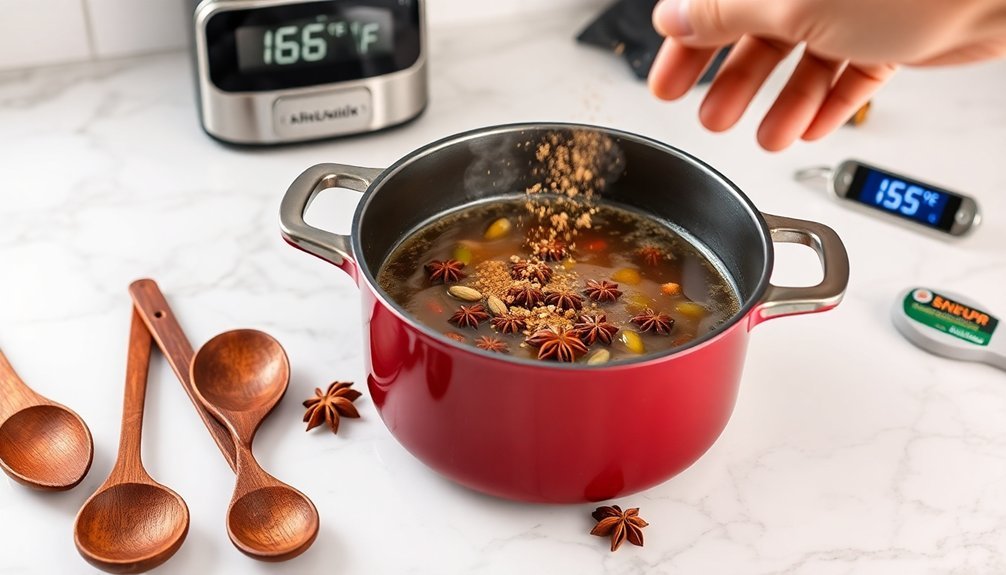



Leave a Reply